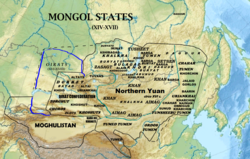Northern Yuan Dynasty
| Northern Yuan dynasty | ||||||||||||||||||
|
ᠬᠦᠮᠠᠷᠳᠦ ᠥᠨ ᠥᠯᠥᠰ Ikh Mongol Uls |
||||||||||||||||||
| Nomadic empire | ||||||||||||||||||
|
||||||||||||||||||
|
The Northern Yuan at its greatest extent
|
||||||||||||||||||
| Capital |
Shangdu (1368–69) Yingchang (1369–70) Karakorum (1371–88) |
|||||||||||||||||
| Languages | Mongolian language | |||||||||||||||||
| Religion | Shamanism, later Buddhism | |||||||||||||||||
| Government | Hereditary monarchy | |||||||||||||||||
| Khagan | For the full list of Mongol khans, see List of Mongol rulers. | |||||||||||||||||
| Legislature |
Yassa Customary rules |
|||||||||||||||||
| Historical era | Late middle ages | |||||||||||||||||
| • | Expulsion of the Mongols from China proper to Mongolia | September 1368 | ||||||||||||||||
| • | The murder of Togus Temur marked the rise of the Oirats. | 1388 | ||||||||||||||||
| • | Dayan Khan reunited the entire Mongol nation. | 1483–1510 | ||||||||||||||||
| • | The death of the last Emperor Ligdan. | 1634 | ||||||||||||||||
| • | Disestablished | 1635 | ||||||||||||||||
| Area | ||||||||||||||||||
| • | 1550 | 5,000,000 km² (1,930,511 sq mi) | ||||||||||||||||
|
||||||||||||||||||
| Today part of |
|
|||||||||||||||||
The Northern Yuan dynasty, or simply the Northern Yuan, was the Mongol regime based in Mongolia homeland after the fall of the Yuan dynasty in China in 1368, until the emergence of the Qing dynasty founded by the Manchus in the 17th century. The Northern Yuan dynasty began with the end of Mongol rule in China and retreat of the Mongols to the Mongolian steppe, and this period was marked by factional struggles and the often only nominal role of the Great Khan.
Dayan Khan and Mandukhai Khatun reunited the entire Mongol nation in the 15th century. However, the former's distribution of his empire among his sons and relatives as fiefs caused the decentralization of the imperial rule. Despite this decentralization there was a remarkable concord within the Dayan Khanid aristocracy and intra-Chinggisid civil war remained unknown until the reign of Ligdan Khan (1604–34), who saw much of his power weakened in his quarrels with the Mongol tribes and was defeated by the Manchus. The last sixty years of this period are marked by intensive penetration of Tibetan Buddhism into Mongolian society.
The period is known by various names, including the Northern Yuan dynasty, or simply the Northern Yuan, although it sometimes refers to the period before 1388, when Toghus Temur was murdered near the Tuul River. The term "Northern Yuan" is derived from the corresponding term (北元) in the Chinese language. The Mongols held the name "Great Yuan" in the early period of this dynasty as in the earlier Yuan dynasty, but they stopped claiming the title Great Yuan since the 15th century except during the reigns of for example Dayan Khan. However, in the English language the term "Northern Yuan (dynasty)" is still used to cover the whole period for historiography reasons. Apart from the name "Great Yuan" in the early period, the Mongols called their nation Ikh Mongol Uls, meaning the "Great Mongol State". It is also referred to as the Post-Imperial Mongolia, Mongol Khaganate, Mongolian Khaganate, Mongol Khanate or Mongolian Khanate in some modern sources, although most of these English terms can also refer to the Mongol Empire or the Yuan dynasty in the 13th and the 14th centuries. In Mongolian chronicles this period is also known as The Forty and the Four, meaning forty tumen eastern Mongols (Eastern Mongolia) and four tumen Western Mongols. Furthermore, Mongolian historiography also use the term "Period of political disunion" and "Period of small khagans" etc.
...
Wikipedia

